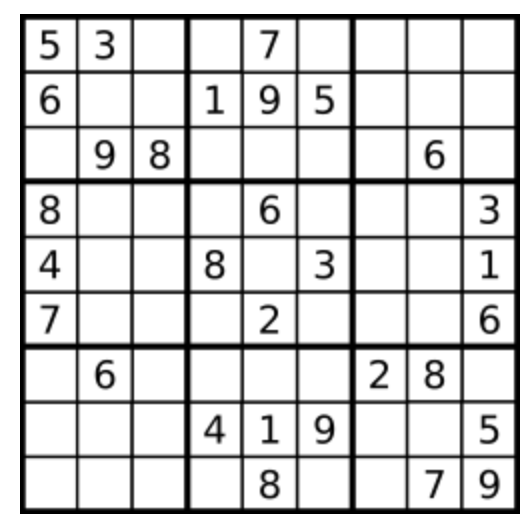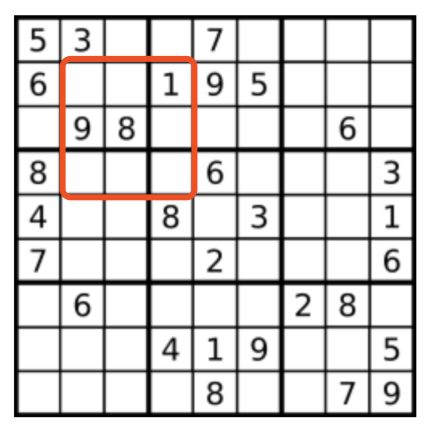1. 原题链接
https://leetcode.com/problems/valid-sudoku/description/
2. 题目要求
给定一个 9✖️9 的数独,判断该数独是否合法
数独用字符类型的二维数组表示,为空的地方用 '.' 代替
合法应满足以下要求:(1)每一列的数字不重复;(2)每一行的数字不重复;(3)3✖️3区域内不存在重复值;下图是一个合法的数独:

3. 解题思路
根据合法应满足的三个要求依此来进行判断:
(1)行和列是否存在重复值:可以通过两层for循环遍历二维数组,然后使用HashSet,因为HashSet不允许存在重复值。依此将遍历到的数字加入HashSet,无法加入时则证明存在重复,返回false;
(2)3✖️3区域内是否存在重复值:
难点:如何经过一次内部for循环就能遍历到一个 3✖️3 区域

假设我们现在要得到红框圈住的3✖️3区域,第一层for循环 i 此时为“1”,第二层for循环 j 从“0”遍历到“8”。如何确保rowIndex和columnIndex的取值范围都是 1~3?
可以发现 “j/3” 和 “j%3”的范围是 0~2,此时的 i =1,因此我们要对这三者进行利用,就能保证rowIndex和columnIndex的取值范围都是 1~3。
4. 代码实现
1 import java.util.HashSet; 2 3 public class ValidSudoku36 { 4 public static void main(String[] args) { 5 char[][] board = {{'5', '3', '.', '.', '7', '.', '.', '.', '.'}, 6 {'6', '.', '.', '1', '9', '5', '.', '.', '.'}, 7 {'.', '9', '8', '.', '.', '.', '.', '6', '.'}, 8 {'8', '.', '.', '.', '6', '.', '.', '.', '3'}, 9 {'4', '.', '.', '8', '.', '3', '.', '.', '1'}, 10 {'7', '.', '.', '.', '2', '.', '.', '.', '6'}, 11 {'.', '6', '.', '.', '.', '.', '2', '8', '.'}, 12 {'.', '.', '.', '4', '1', '9', '.', '.', '5'}, 13 {'.', '.', '.', '.', '8', '.', '.', '7', '9'}}; 14 System.out.println(isValidSudoku(board)); 15 } 16 17 public static boolean isValidSudoku(char[][] board) { 18 for (int i = 0; i < board.length; i++) { 19 HashSet<Character> row = new HashSet<Character>(); 20 HashSet<Character> column = new HashSet<Character>(); 21 HashSet<Character> cube = new HashSet<Character>(); 22 for (int j = 0; j < board.length; j++) { 23 if (board[i][j] != '.' && !row.add(board[i][j])) 24 return false; 25 26 if (board[j][i] != '.' && !column.add(board[j][i])) 27 return false; 28 29 int rowIndex = 3 * (i / 3); 30 31 int columnIndex = 3 * (i % 3); 32 System.out.print(rowIndex + j / 3+","); 33 System.out.print(columnIndex + j % 3+" "); 34 if (board[rowIndex + j / 3][columnIndex + j % 3] != '.' && !cube.add(board[rowIndex + j / 3][columnIndex + j % 3])) 35 return false; 36 } 37 System.out.println(""); 38 System.out.println(""); 39 } 40 return true; 41 } 42 }